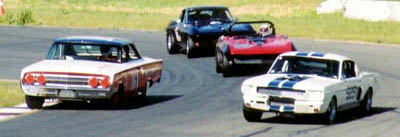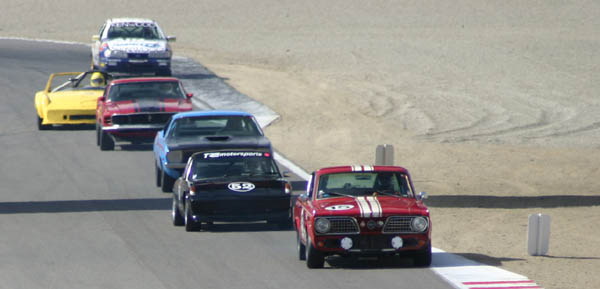 |
TEAM STARFISH Vintage Racing |
Listing of Vintage Racing Organizations
| About Vintage Racing |
 Vintage racing is not like your average club racing, as victory is
not obtained "at all costs". The emphasis on vintage racing is on
participation, respect for the machinery, and others on the track.
That is not to say however, that it is not "racing"! There is
competition going on all over the racetrack. The main difference
though, is that in vintage racing you are to allow a bubble, or
space around the other guy. Risky moves that can damage other cars,
or yours, are severely frowned upon. I don't know about you, but I
would feel awful if a dumb move I made caused damage to a
multi-million dollar Ferrari GTO, or anybody else's car for that
matter. Vintage racing is not like your average club racing, as victory is
not obtained "at all costs". The emphasis on vintage racing is on
participation, respect for the machinery, and others on the track.
That is not to say however, that it is not "racing"! There is
competition going on all over the racetrack. The main difference
though, is that in vintage racing you are to allow a bubble, or
space around the other guy. Risky moves that can damage other cars,
or yours, are severely frowned upon. I don't know about you, but I
would feel awful if a dumb move I made caused damage to a
multi-million dollar Ferrari GTO, or anybody else's car for that
matter.
In vintage racing, everybody has equal rights to the track. There are usually large disparities between the fast cars, and the slow cars. Often, this is as much as 30 seconds a lap. One reason for this is the disparity in car performance. A 750cc Fiat might be on the track at the same time as a 2 liter Porsche. A big block Cobra might be on the track the same time a 1.6 liter Datsun Roadster is. Some drivers drive more aggressively and push things to the limit more than others. In vintage racing, one should not be driving 100% "at the edge", as would be expecting from professional or club racing. Usually, 90% is the rule. Unfortunately, not everybody subscribes to these rules, as evidenced by crashes and spins at almost every race. The sanctioning bodies usually impose a "13/13" rule when body contact occurs that is deemed to be your fault. For "minor" incidents, one is put on 13 months probation. For "reckless" or "serious" incidents, one can be suspended from competition for as long as 13 months, or even be banned forever. Some sanctioning groups are more serious about this than others.
Car preparation is another area where vintage racing is different. In professional, or club racing, there are many aftermarket systems that are allowed, such as Wilwood rear disk brakes, or Richmond 5 speed transmissions. In vintage racing, the cars must be presented in the condition they would have been during the period raced. This means that the car must be presented as listed either on the FIA Homologation papers, or the period SCCA Production Car Specifications (PCS) sheets. (For more information on this, click on FIA Holomogation link on sidebar.) This means that a car that had only drum brakes available when it was manufactured must use period drum brakes. (That is why I am using drum rear brakes on the Starfish Barracuda). Some groups, such as the Classic Sports Racing Group (CSRG) do not want full cages in cars, since they did not race that way in the '50s and early '60s, and provide an extra amount of chassis stiffness which was not available then. Others, like some Sports Club of America (SCCA) vintage events are "race what you brung", where almost anything goes! Every one of the vintage sanctioning organizations encourage, and most demand, standard safety systems in the cars, most of which was not used during the era of competition. This includes enclosed fuel cells, halon fire systems, and emergency electrical cut-off switches. These are used to keep the sport as safe as possible.
What is the cost? In a word: EXPENSIVE. Entry fees cost between $300 and $450 per weekend. Tires, which run $800 a set, last about 3-4 races. Race gas for the weekend runs about $100. By the time you add up wear-and-tear on the car, gas, tires, entry fees, gas for the tow vehicle, you are looking at about $1,000-$1,200 per weekend! Not for the light-of-wallet, that is for sure, but some people (like us) manage to eke out racing on a shoestring budget by doing most of the work ourselves. The bottom line for vintage racing: Have fun, enjoy driving your car, but be safe!
|
